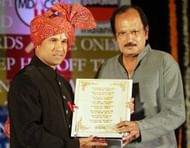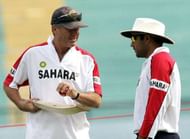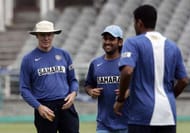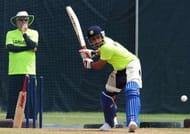The hunt for the next coach of the Indian Cricket Team is in full swing now, with the Board of Control for Cricket in India (BCCI) having already narrowed it down to 21 candidates, down from 57 applicants who had applied for the role, at the expiry of the deadline for applications on June 10. The board’s cricket advisory committee, comprising of Sachin Tendulkar, Sourav Ganguly and VVS Laxman has been tasked with the job of finalising the right man for the position of the Head Coach of the Indian cricket team.
Over the years, cricket coaches have been seen forming close associations with players while they have also been seen to have fallen foul and out of favour, as such. There are several examples to cite regarding this from within Indian cricket itself, such as Sourav Ganguly’s contrasting relationship with two coaches that he played under – John Wright and Greg Chappell. However, these associations and differences put aside, each coach has, undoubtedly, nurtured new talents and has helped the established players mature under his guidance. Here, in this piece, we bring to you five Indian coaches and the players who were their crowning jewels.
#1 Ajit Wadekar and Sachin Tendulkar (1992-1996)
Arguably, India’s most underrated and the greatest Test captain, Ajit Wadekar, had a fairly successful coaching tenure between 1992 and 1996. Wadekar’s coaching career and Mohammad Azharduddin’s captaincy tenure coincided to give India some of their memorable home victories during the aforementioned period. India remained unbeaten in Tests for a stretch of 14 games between 1992-1994, including a 3-0 whitewash of England at home. Several careers peaked during Wadekar’s tenure, such as those of the captain Azhar and players like Navjot Sidhu, but beyond a shadow of a doubt, Wadekar’s greatest protege was the then 20-year-old, Sachin Tendulkar.
After having an ordinary start to his Test career in 1989 wherein he could score only 215 runs from 4 Tests at an average of 35, Tendulkar thrived under the guidance of his senior Mumbaikar, and had three of the best formative years of his batting career, as in 1992, 1993 and 1994 the right-hander scored 419, 640 and 700 runs respectively averaging 41.90, 91.42 and 70.00. The peaks that Tendulkar achieved during the following years – in 1997, 1999 and 2001, wherein he scored more 1000 Test runs – were majorly due to the foundation that was laid during his nascent years in international cricket. In 1994 and 1996, the Mumbaikar scored more than 1000 runs in ODI cricket as well.
#2 John Wright and Virender Sehwag (2000-2005)
Former New Zealand captain, John Wright, became the first foreign coach of the Indian Cricket Team after the tenure of the previous coach, Kapil Dev, unceremoniously ended in the wake of the match-fixing allegations levelled by Dev’s one-time teammate and Indian fast bowler, Manoj Prabhakar. Later, after a legal tussle, these allegations were found to be false. One place where similar allegations were proven and testified was the spot-fixing saga of 2000 that saw ace Indian cricketers such as Mohammad Azharuddin and Ajay Jadeja getting banned from competitive cricket. The team’s and the nation’s morale was hurt and Indian cricket needed a saviour to bail them out of the dire straits.
It was then that two changes happened at the helm of the Indian cricketing fraternity. Sourav Ganguly was appointed as the captain of the team and John Wright was appointed as the coach. Thereafter, it took only a year for these changes to show their effects, when India defeated Australia 2-1 in three-match Test series in 2001, with one of those victories – at the Eden Gardens, Kolkata – coming after the team was asked to follow-on. Wright’s coaching career began with the cricketing career of one of India’s most famous, flamboyant, and in-your-face cricketers, Virender Sehwag. A century on Test debut against South Africa away from home against an attack comprising of Shaun Pollock and Makhaya Ntini had already exhibited his potency with the bat.
After having ordinary yet impressive first two years in Test cricket, Sehwag came to his own in 2003 and 2004, garnering 522 runs from 5 Tests and 1141 runs from 12 Tests respectively, including the famous 309 against Pakistan in Multan in 200,4 that laid the foundation for India's first ever Test series victory on Pakistani soil. However, Sehwag carved out a niche for himself – at least during his formative years – in the shorter format of the game, as in ODI cricket, the Delhi-born cricketer redefined the art of batsmanship by taking on the bowlers right from ball 1 and turned to reality the once unfathomable strike-rates of more than 100 runs per 100 balls on a consistent basis. In 2002, he scored 1130 runs from 30 ODIs at a strike-rate of 105.
#3 Greg Chappell and MS Dhoni (2005-2007)
Although the former Australian captain had a short association with the Indian Cricket Team and also had rumours of his foul relationship with the then captain, Ganguly, floating around during his tenure, Greg Chappell would probably be remembered as the coach who inculcated the knack for experimentation into the Indian team. Whether it was sending Irfan Pathan to open the batting or asking Rahul Dravid to keep wickets, Chappell had his own way of leading the team forward. His record, however, was a mixed bag of victories and defeats and was let off by the BCCI after India’s ignominious exit from the 2007 Cricket World Cup.
Notwithstanding all of that, not everything was gloomy and out of the line in the Indian team under Chappell. The Australian’s tenure saw the rise of arguably the greatest ever limited-overs captain that India has ever seen, MS Dhoni. Between 2005 and 2007, Dhoni established himself as the go-to man in crisis situations and made a name for himself as the man who could change the face of the game through sheer power and muscle as opposed to touch, stroke-play, and finesse. The Jharkhand-born cricketer’s batting average never dropped below 40 between 2005 and 2007 – despite coming in to bat at No. 5, 6 or 7 – and the strike-rate consistently touched 90 runs per 100 balls.
Dhoni’s partnerships with Yuvraj Singh during the ODI series in Pakistan in 2006 – which India won 4-2 – saw tough run chases being reduced to cakewalks, and established the right-handed wicket-keeper batsman as one of the best finishers in international limited-overs cricket. The cricketer’s crowing achievement came just after Chappell’s contract had been terminated, when immediately after the 50-over World Cup in 2007, Dhoni led India to their maiden ICC World T20 title in South Africa.
#4 Gary Kirsten and Virat Kohli (2008-2011)
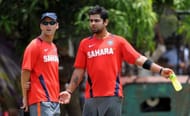
Right up there in the list of the most successful coaches for the Indian Cricket Team has been the former South African opening batsman, Gary Kirsten. India’s change of fortunes within the span of a few months – from the first round ouster in the 50-over World Cup to the title victory at the 20-over version – demanded attention and called for a proper full-time head coach. It was then that the BCCI played another masterstroke and roped in Kirsten for the role, and over the years, the South African combined with the then and incumbent Indian limited-overs captain, MS Dhoni, to take India to unprecedented heights. India won a tri-series in Australia in 2008, reached the No. 1 spot in the ICC Test Rankings in 2009, and won the Asia Cup in 2010. All of these achievements over a sustained period of time culminated in India's ICC Cricket World Cup victory in 2011.
Kirsten shared a very good rapport with the Dhoni, as he did with several senior players in the side, such as Rahul Dravid, Sachin Tendulkar and VVS Laxman. However, the youngster who rose to prominence, and whose career was shaped under the able guidance of the South African was Virat Kohli. During Kohli’s unbelievable run in limited-overs cricket, something that has continued to this date, Kirsten was at the helm and took good care of the aggressive Indian batsman. From 2009 to 2011, Kohli consistently averaged above 45 in ODI cricket and also scored more than 1000 runs in 2011. The Delhi-born batsman scored 8 centuries and 17 half-centuries during the aforementioned period and lead India to many memorable victories.
#5 Duncan Fletcher and Rohit Sharma (2011-2015)
Although the world had seen glimpses of the young Rohit Sharma during the ICC World T20 2007, he bloomed to his full potential post-2012, especially after he was allotted the opener’s slot for the first time in 2013. The ICC Champions Trophy held in England the same year saw Rohit give India solid opening stands along with the newly-discovered left-handed mauler, Shikhar Dhawan, and it was only the beginning of a dream run that was about to unfold for the Mumbai cricketer. The man behind such a tactical move, in popular opinion, was the then Indian coach, and the man who succeeded Kirsten after the 2011 World Cup victory, Duncan Fletcher.
Two double hundreds in ODI cricket – one in 2013 against Australia (209), and the other, which is the record highest individual score in ODI cricket (264), against Sri Lanka – came during Fletcher’s tenure which clearly indicated that the shift from the middle order to the top of the order had worked wonders for the right-handed batsman. The Mumbaikar’s opening partnerships with Dhawan laid the foundations for many Indian victories, especially on home soil, and both them have solidified themselves at the top of the Indian batting order in limited-overs cricket. Rohit’s performances in the ICC Cricket World Cup in 2015 were also noteworthy, wherein he scored a match-winning century against Bangladesh in the quarter-final at the Melbourne Cricket Ground.
Check RCB Squad 2024 Details. Follow Sportskeeda for IPL 2024 Live Score, Schedule, Points Table
